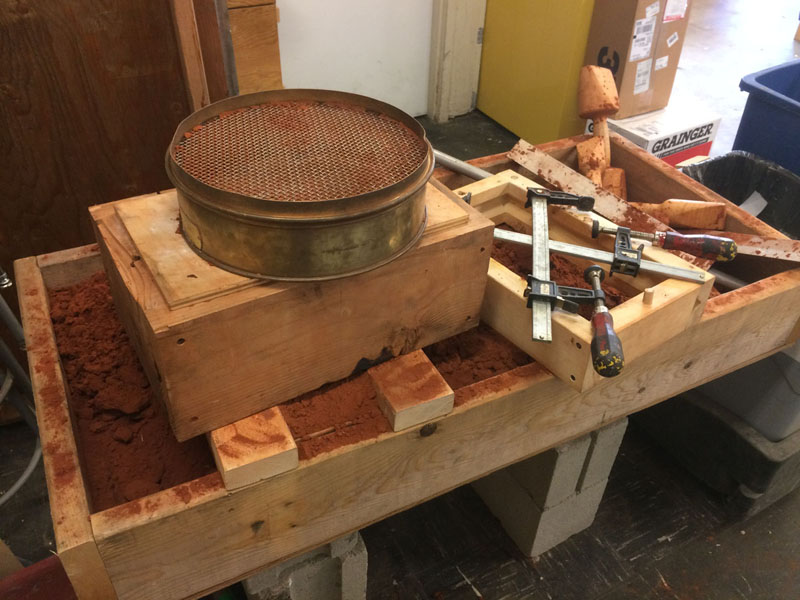Aluminum Foundry Wisconsin continues as a pillar of casting services
How Aluminum Foundry Adds To Innovations in Aerospace Design
Aluminum foundries are integral to advancements in aerospace design. They create light-weight, high-strength parts that are crucial for contemporary airplane. With innovative spreading techniques, these foundries develop intricate geometries that boost architectural integrity. In addition, the growth of premium Aluminum alloys supports the market's focus on fuel efficiency and sustainability. Obstacles continue to be in the manufacturing procedure. Comprehending these variables exposes the profound impact of Aluminum on air travel's future.
The Significance of Lightweight Products in Aerospace Layout
As the aerospace industry proceeds to advance, the importance of lightweight materials becomes increasingly evident. The need for efficiency and sustainability drives engineers to focus on making use of materials that decrease total weight without endangering architectural honesty. Lightweight materials, specifically Aluminum, play an essential role in enhancing fuel effectiveness, boosting haul ability, and enhancing the general performance of aircraft.
Additionally, the integration of these products enables ingenious layouts, allowing suppliers to develop even more aerodynamic forms that can withstand extreme problems. The reduction in weight not just lowers functional prices however likewise adds to a reduced environmental footprint, aligning with global initiatives towards sustainability in air travel.
Advanced Casting Techniques in Aluminum Foundries
Advanced casting techniques in Aluminum shops play a vital role in aerospace engineering by enabling the manufacturing of exact and light-weight components. Innovations in mold design and precision spreading procedures are important in achieving ideal efficiency and structural integrity. In addition, the advancement of lightweight alloys boosts the general performance and efficiency of aerospace applications.
Innovative Mold Style
Cutting-edge mold and mildew layout plays a necessary duty in the performance and effectiveness of Aluminum shops, specifically within the aerospace sector. By leveraging advanced products and strategies, contemporary molds can be crafted to endure high temperature levels and pressures, making certain peak performance during the spreading process. These designs commonly incorporate intricate geometries that enable the manufacturing of light-weight yet structurally audio parts, essential for aerospace applications. Furthermore, making use of computer-aided design (CAD) software program helps with precise modeling, enabling factories to refine and replicate mold designs before physical manufacturing starts. This not just enhances the quality of cast parts however also minimizes waste and preparation, resulting in significant expense financial savings. In general, innovative mold and mildew layout is a foundation of development in Aluminum Foundry technology for aerospace design.
Accuracy Casting Processes
The effectiveness of cutting-edge mold and mildew designs seamlessly integrates with precision spreading procedures, which are vital for generating high-grade Aluminum components in aerospace engineering. These processes, consisting of sand casting, die casting, and financial investment spreading, ensure the creation of complex geometries with limited tolerances. Advanced methods like vacuum cleaner casting and stress pass away casting improve the stability and surface area coating of the last items. Accuracy spreading decreases product waste while maximizing the mechanical homes of Aluminum, crucial for aerospace applications. Additionally, employing real-time surveillance and progressed simulation tools throughout the casting procedure enables prompt changes, causing improved quality assurance. Jointly, these accuracy spreading processes position Aluminum shops at the leading edge of aerospace development, sustaining the industry's need for integrity and performance.
Lightweight Alloy Advancement
As aerospace designers look for to enhance fuel performance and efficiency, lightweight alloy advancement ends up being a necessary emphasis in Aluminum foundries. These foundries utilize advanced casting techniques to create alloys that give premium strength-to-weight proportions. Advancements in alloy structure, consisting of the consolidation of elements like lithium and magnesium, enable the manufacturing of materials that withstand severe conditions while decreasing general airplane weight. Techniques such as die casting and financial investment casting facilitate the precision production of intricate shapes, which are essential for aerospace applications. Additionally, recurring research intends to optimize these alloys for enhanced mechanical residential properties and increased toughness. By focusing on light-weight alloy development, Aluminum factories significantly add to the development of aerospace engineering, leading the way for more lasting and effective airplane designs.

Enhancing Architectural Honesty Through Aluminum Parts
Aluminum components offer significant advantages in improving architectural honesty within aerospace engineering. Their light-weight nature adds to overall efficiency while maintaining strength, which is important for aircraft performance. In addition, the stress resistance residential or commercial properties of Aluminum help guarantee the toughness and integrity of aerospace structures under different operational problems.
Light-weight Product Perks
While conventional materials frequently jeopardize weight for stamina, making use of Aluminum parts in aerospace design provides significant benefits in structural integrity. Aluminum's light-weight nature adds to overall design performance, permitting more structured aircraft that consume much less fuel, therefore improving sustainability. The material's excellent strength-to-weight proportion assurances that components keep resilience without including unnecessary mass. This top quality promotes improved performance and agility in flight, along with enhanced haul capacities. In addition, Aluminum's resistance to rust lengthens the life expectancy of aerospace structures, minimizing maintenance costs and boosting security. As makers increasingly embrace Aluminum alloys, the aerospace sector experiences a transformative shift in the direction of much more reliable and effective engineering remedies that prioritize both performance and ecological obligation.
Stress And Anxiety Resistance Properties
Different products have unique residential properties, Aluminum's extraordinary tension resistance stands out as a critical variable in boosting the structural integrity of aerospace components. This resistance plays a vital function in making certain that airplane can stand up to different functional stresses, including tiredness, influence, and ecological problems. Aluminum alloys, especially crafted for aerospace applications, display high tensile toughness while keeping light-weight features, making it possible for designers to design more efficient structures - Aluminum Foundry. In addition, the capacity of Aluminum to sustain cyclic loading without substantial contortion adds to the long life and reliability of aerospace elements. As developments continue in Aluminum Foundry methods, the development of stress-resistant Aluminum components assures more renovations in efficiency, safety and security, and efficiency across the aerospace sector, strengthening Aluminum's role as a preferred product in modern-day engineering
Gas Performance Improvements Driven by Aluminum Innovations
As the aerospace market seeks to boost gas effectiveness, innovative uses Aluminum have actually become a vital service. Aluminum's light-weight nature especially decreases aircraft weight, permitting for reduced fuel intake during flight. This decrease in weight is important, as also tiny reductions can lead to considerable renovations in overall gas economic climate.
Advanced Aluminum alloys, designed for enhanced toughness and toughness, allow manufacturers to produce components that preserve click to read architectural stability while minimizing mass - Aluminum Foundry. Furthermore, the assimilation of Aluminum in airframes and engine elements promotes improved the rules of aerodynamics, contributing to minimized drag and increased efficiency
The adoption of Aluminum in aerospace not just meets the demand for fuel-efficient layout however likewise straightens with regulatory pressures for reduced emissions. As these advancements remain to progress, they play a substantial duty in establishing new criteria for fuel efficiency, making certain that the aerospace field can satisfy expanding economic and environmental obstacles.

The Function of Aluminum in Sustainable Aeronautics Practices
The raising focus on lasting air travel methods has actually positioned Aluminum as a necessary product in the pursuit for greener airplane style. Recognized for its lightweight buildings, Aluminum substantially lowers aircraft weight, bring about reduced gas usage and discharges. Its recyclability even more improves its sustainability profile, as Aluminum can be recycled forever without loss of high quality. This particular supports a round economy within the aeronautics sector, minimizing waste and source depletion.
Furthermore, developments in Aluminum alloys have actually enhanced their strength and rust resistance, permitting longer life span and minimized maintenance needs. These advancements help with the development of a lot more efficient airplane frameworks, adding to total sustainability efforts. In addition, Aluminum's thermal conductivity plays a crucial function in energy-efficient designs, improving systems such as warm exchangers. Collectively, these attributes highlight Aluminum's pivotal duty ahead of time lasting aeronautics, straightening with worldwide efforts focused on decreasing the environmental impact of air traveling.
Challenges Dealt With by Aluminum Foundries in Aerospace Manufacturing
While Aluminum shops play a crucial function in aerospace manufacturing, they deal with considerable obstacles that can impact manufacturing effectiveness and high quality. One significant challenge is the rigid quality control requirements called for in the aerospace industry. Any flaw can endanger safety and performance, requiring extensive examination processes that extend production timelines. Furthermore, factories usually emulate varying raw product prices, which can Related Site influence pricing and success. The complexity of Aluminum alloys utilized in aerospace applications additional complicates the manufacturing process, as precise formulations are important for attaining wanted mechanical properties. Experienced labor shortages hinder the capability to preserve top quality manufacturing levels. Finally, environmental laws impose constraints on exhausts and waste monitoring, needing factories to invest in sustainable techniques, which can be cost-prohibitive. These elements collectively develop a landscape where Aluminum foundries have to constantly adjust to satisfy the evolving needs of aerospace manufacturing while guaranteeing safety and conformity.
Future Trends in Aluminum Applications for Aerospace Design
With innovations in innovation and enhancing demands for performance, the future of Aluminum applications in aerospace engineering is positioned for considerable change. The integration of innovative Aluminum alloys and compounds is anticipated to boost strength-to-weight ratios, leading to even more fuel-efficient airplane styles. Furthermore, innovations in additive manufacturing methods will certainly allow for the production of complex Aluminum structures that were previously impossible, maximizing efficiency and decreasing waste.

Lasting practices will certainly play an essential role, with a growing focus on recycling Aluminum to decrease ecological influence. The aerospace sector is likely to embrace smarter manufacturing processes, such as automation and expert system, making sure better and accuracy in Aluminum parts. In addition, partnerships in between Aluminum factories and aerospace companies will cultivate r & d, leading the way for brand-new applications that meet the rigid requirements of modern aerospace design - Aluminum Foundry. Overall, the future looks promising for Aluminum's role in forming the skies
Regularly Asked Inquiries
What Are the Ecological Effects of Aluminum Production in Aerospace?
The environmental impacts of Aluminum production in aerospace consist of considerable energy consumption, greenhouse gas exhausts, and environment interruption. Furthermore, mining processes can bring about dirt degradation and water contamination, raising issues regarding sustainability and environmental balance.
Just How Does Aluminum Compare to Other Materials in Aerospace Applications?
Aluminum supplies a special combination of lightweight homes, deterioration resistance, and cost-effectiveness compared to various other materials. Its high strength-to-weight proportion makes it specifically advantageous for aerospace applications, improving fuel effectiveness and total performance in aircraft style.
What Qualifications Do Aluminum Foundry Workers Demand for Aerospace Projects?
Aluminum Foundry workers need specialized training in metallurgy and casting strategies, together with knowledge of aerospace sector requirements. Certifications in quality assurance and safety procedures are also vital to guarantee conformity with strict aerospace project needs.
Are There Any Security Concerns With Making Use Of Aluminum in Aerospace Engineering?
Safety concerns relating to Aluminum in aerospace design include vulnerability to deterioration, fatigue, and anxiety fractures. Appropriate treatment and alloy option are necessary to minimize these dangers, ensuring structural integrity and general safety and security in aerospace applications.
Just How Does Aluminum Recycling Benefit the Aerospace Industry?
Aluminum reusing substantially benefits the aerospace industry by reducing product expenses, decreasing ecological effect, and saving energy. This sustainable practice enhances the sector's effectiveness while promoting using light-weight, high-performance parts in airplane production.
Advanced casting methods in Aluminum factories play an essential function in aerospace design by making it possible for the production of exact and lightweight components. Innovative mold layout plays a crucial duty in the Read Full Report effectiveness and efficiency of Aluminum foundries, specifically within the aerospace industry. As aerospace engineers look for to improve fuel efficiency and efficiency, light-weight alloy advancement becomes an important focus in Aluminum shops. Aluminum alloys, especially engineered for aerospace applications, exhibit high tensile toughness while keeping lightweight attributes, enabling designers to make a lot more effective structures. Collaborations in between Aluminum factories and aerospace companies will foster study and advancement, paving the way for brand-new applications that meet the rigorous demands of modern-day aerospace engineering.